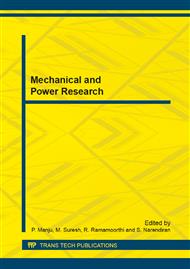[1]
M. P. Kazmierkowski, R. Krishnan, and F. Blaabjerg, Control in Power Electronics. London, U.K.: Academic, (2002).
Google Scholar
[2]
M. Godoy Simões and F. A. Farret, Alternative Energy Systems: Design and Analysis With Induction Generators, 2nd ed. Boca Raton, FL: CRC Press.
Google Scholar
[3]
H. Li and Z. Chen, Overview of different wind generator systems and their comparisons, IET Renew. Power Gen., vol. 2, no. 2, p.123–138, Jun. (2008).
Google Scholar
[4]
A. G. Abo-Khalil, D. -C. Lee, and J. -K. Seok, Variable speed wind power generation system based on fuzzy logic control for maximum output power tracking, in Proc. 35th Annu. IEEE PESC, Aachen, Germany, 2004, p.2039–(2043).
DOI: 10.1109/pesc.2004.1355431
Google Scholar
[5]
R. Cárdenas and R. Peña, Sensorless vector control of induction ma- chines for variable-speed wind energy applications, IEEE Trans. Energy Convers., vol. 19, no. 1, p.196–205, Mar. (2004).
DOI: 10.1109/tec.2003.821863
Google Scholar
[6]
L. Mihet-Popa, F. Blaabjerg, and I. Boldea, Wind turbine generator mod-eling and simulation where rotational speed is the controlled variable, IEEE Trans. Ind. Appl., vol. 40, no. 1, p.3–10, Jan. /Feb. (2004).
DOI: 10.1109/tia.2003.821810
Google Scholar
[7]
R. Leidhold, G. Garcia, and M. I. Valla, Maximum efficiency control for variable speed wind driven generators with speed and power limits, in Proc. 28th Annu. Int. Conf. IEEE Ind. Electron. Soc., Seville, Spain, Nov. 5–8, 2002, p.157–162.
DOI: 10.1109/iecon.2002.1187499
Google Scholar
[8]
M. G. Simões, B. K. Bose, and R. J. Spiegel, Fuzzy-logic-based intelli- gent control of a variable speed cage machine wind generation system, IEEE Trans. Power Electron., vol. 12, no. 1, p.87–95, Jan. (1997).
DOI: 10.1109/63.554173
Google Scholar
[9]
M. G. Simões, B. K. Bose, and R. J. Spiegel, Design and performance evaluation of a fuzzy-logic-based variable-speed wind generation sys- tem, IEEE Trans. Ind. Appl., vol. 33, no. 4, p.956–965, Jul. /Aug. (1997).
DOI: 10.1109/28.605737
Google Scholar
[10]
T. Thiringer and J. Linders, Control by variable rotor speed of a fixed- pitch wind turbine operating in a wide speed range, IEEE Trans. Energy Convers., vol. 8, no. 3, p.520–526, Sep. (1993).
DOI: 10.1109/60.257068
Google Scholar
[11]
T. Senjyu, Y. Ochi, E. Muhando, N. Urasaki, and H. Sekine, Speed and position sensorless maximum power point tracking control for wind generation system with squirrel-cage induction generator, in Proc. PSCE, Oct. 29–Nov. 1, 2006, p.2038–(2043).
DOI: 10.1109/psce.2006.296238
Google Scholar
[12]
M. Y. Uctug, I. Eskandarzadeh, and I. H. Ince, Modelling and out- put power optimisation of a wind-turbine-driven double-output induction generator, Proc. Inst. Elect. Eng. —Elect. Power Appl., vol. 141, no. 2, p.33–38, Mar. (2004).
DOI: 10.1049/ip-epa:19949983
Google Scholar
[13]
M. Karrari, W. Rosehart, and O. P. Malik, Comprehensive control strat- egy for a variable-speed cage machine wind generation unit, IEEE Trans. Energy Convers., vol. 20, no. 2, p.415–423, Jun. (2005).
DOI: 10.1109/tec.2005.845525
Google Scholar
[14]
Etienne Tremblay, Sergio Atayde, and Ambrish Chandra, Comparative Study of Control Strategies for the Doubly Fed Induction Generator in Wind Energy Conversion Systems: A DSP-Based Implementation Approach, IEEE Trans. Sustainable Energy., vol. 2, no. 3, pp.288-299, July. (2011).
DOI: 10.1109/tste.2011.2113381
Google Scholar
[15]
R. Pena and J. C. Clare, Doubly fed induction generator using back-to back PWM converters and its application to variable-speed wind-energy generation, Proc. IEEE, Electric Power Applications, vol. 143, no. 3, p.231–241, May (1996).
DOI: 10.1049/ip-epa:19960288
Google Scholar
[16]
Gilsung Byeon, In Kwon Park and Gilsoo Jang, Modeling and Control of a Doubly-Fed Induction Generator (DFIG) Wind Power Generation System for Real-time Simulations, Journal of Electrical Engineering & Technology Vol. 5, No. 1, p.61~69, (2010).
DOI: 10.5370/jeet.2010.5.1.061
Google Scholar
[17]
Gilsung Byeon, In Kwon Park and Gilsoo Jang, Modeling and Control of a Doubly-Fed Induction Generator (DFIG) Wind Power Generation System for Real-time Simulations, Journal of Electrical Engineering & Technology Vol. 5, No. 1, p.61~69, (2010).
DOI: 10.5370/jeet.2010.5.1.061
Google Scholar
[18]
Ritika Verma and Prof. Amol Barve Vector control of a Grid Interface Wind-DFIG Hybrid System with SOFC Fuel cell, International Journal of Emerging Research in Management &Technology ISSN: 2278-9359, p.96 – 104, Jan (2013).
Google Scholar


